Mental
The second of the London County Asylums in the Epsom cluster to be built by the LCC on 88 acres of the Horton estate, Horton Asylum, opened in 1902. An exact replica of Bexley Asylum, it had 2000 beds. It had been built quickly, the work being carried out in all weathers, by day and by night, and transportation of building materials to the site had resulted in the local roads, especially Hook Road, being completely ruined.
A fenced-off strip of land at the northeast corner of the site served as a burial ground for all the pauper inmates of the planned asylums on the estate. Known as Horton Cemetery, it opened in 1899; each grave usually contained three or four bodies. (The Cemetery closed in 1955 and its chapel was demolished during the 1960s).
In 1915 the Asylum was taken over by the Army Council and its 2143 inmates were transferred over four weeks to its sister asylums in the area. It became the Horton (County of London) War Hospital, a general hospital for servicemen from all parts of the Empire wounded during WW1. King George V and Queen Mary visited in July 1916, by which time there were almost 2000 military patients.
In 1919, after it had treated over 46,000 patients, it was handed back to the LCC. In 1920 it was reinstated as a mental hospital and renamed Horton Mental Hospital, treating mainly female patients. By 1922 it had 1605 patients, of whom only 187 were men. (By 1927 there were 1961 patients - 270 of whom were men.)
In 1925 the Malaria Therapy unit, under the command of Lt.-Col. S.P. James (1870-1946), transferred from The Manor to the Hospital's 14-bed isolation block. The block was named 'C' Hospital and also contained a separate specialist laboratory for the breeding of mosquitoes and the study of malaria.At the end of August, 1939, just before the outbreak of WW2, its psychiatric patients were once again transferred to neighbouring hospitals (within 8 hours!) and it once more became a general hospital as part of the Emergency Medical Service (EMS), with 2178 beds. It was renamed the Horton Emergency Hospital, treating battle and air-raid casualties and the civilian sick. The Malaria Therapy Unit continued its own work. Medical staff were sent from several London teaching hospitals, namely King's College Hospital, St Thomas's Hospital, Guy's Hospital and Westminster Hospital. In 1944 it had 2330 beds.
By the time the war ended the Hospital's buildings and grounds were in a grievous state. It ceased to be an Emergency Hospital in March 1948. The EMS had evacuated the buildings during 1947-48, leaving wards derelict (no improvements had been made during the war). Trained mental care nurses were in short supply, further restricting the opening of wards. However, by July 1947, the first batch of its mental patients returned from The Manor, then from Cane Hill Hospital, Long Grove Hospital and St Ebba's Hospital.
In 1948 the Hospital joined the NHS under the control of the Horton Hospital Medical Committee, part of the South West Metropolitan Regional Hospital Board, becoming a mental hospital again in 1949. It had 527 beds, with 93 male patients in three wards and 255 females in six wards, but only a small nucleus of mental trained nurses. Recruitment of student nurses started immediately. By the end of 1949 the Hospital had managed to open 11 female wards and 8 male ones.
With the advent of the NHS, the centralised allocation of beds by the LCC from County Hall (under this arrangement patients were sent to any mental hospital which had beds available, regardless of where they lived in London) was abandoned. Each hospital in the Epsom cluster received patients from designated catchment areas in one of the new NHS Metropolitan Regions. Thus, patients from the Boroughs of Wimbledon, St Marylebone, Paddington, Holborn, Hampstead and part of the City of Westminster (all, with the exception of Wimbledon, were in the North West Metropolitan Region) were sent to Horton Hospital.
In 1950 work to modernise and improve the wards and equipment finally began. The wards were refloored, but the use of teak was prohibited because of its cost, and linoleum was used instead. By 1955 the Hospital had 1386 beds but, by 1956, was overcrowded by 12%, with 1554 patients. The Hospital had a modern X-ray Department capable of undertaking all types of investigation; this service was used also by Long Grove Hospital and West Park Hospital. There were also Occupational Therapy and Industrial Therapy Departments. A Ladies' Hairdresser had also been appointed.
The Mental Health Act, 1959, had far-reaching medical and administrative implications. The majority of certified patients (80%) were given informal status. However, rehabilitation of patients proved difficult because of the geographical distance of the Hospital from its catchment areas (some 20-25 miles away), as well as the lack of trained psychiatric social workers and the shortage of hostel accommodation. During the preceding 20 years life expectancy of patients had increased, with the elderly becoming psychiatric casualties as senile psychoses, arteriosclerotic dementia and senile paranoid states became more prevalent. The Hospital had a high admission rate of patients over 65 years of age and, like other psychiatric hospitals, was in danger of becoming a dumping grounds for long-stay psychotic and psychogeriatric patients.The Act required that the word 'mental' be omitted from hospital names to emphasize that patients were on an equal footing regardless of what kind of hospital they were in. Horton Mental Hospital thus became Horton Hospital.
An unexpected repercussion of the Mental Health Act was the extraordinary rise in admissions via the police, prisons and Courts of Law. In 1961 some 100 males and 25 females had been admitted and, by 1962, 130 males and 18 females, with the numbers unlikely to fall in future years. Horton Hospital had the dubious honour of admitting more mentally ill offenders than any other single hospital in the country. This was probably because its catchment areas included a number of railway termini, where drifters from all over the country, including many with chronic psychoses, were deposited, and a number of police courts at which offenders of no fixed abode were charged. However, because the Hospital lacked secure accommodation, there was a high rate of absconding.
In 1960 the Central Boiler House supplying all five hospitals in the cluster was re-equipped at a cost of £542,302 and the Horton Hospital Management Committee took over responsibility for it. By this time the Epsom cluster had 7000 beds, 1524 of which were at Horton Hospital.
In 1961 the west end of the chapel was partitioned off and became the Music Therapy Centre. It was officially opened by the Countess of Harewood. In 1963 it was renamed Harewood Hall. The 'A' Hospital (the admission unit for male patients) was renamed Linfield House, after A.G. Linfield, Chairman of the South West Metropolitan Regional Hospital Board. The 'B' Hospital (the admission unit for female patients) was renamed Sersale House, after H.H. Sersale, Chairman of the Hospital Hospital Management Committee from 1955-1960. Horton House, once the Medical Superintendent's residence, was adapted for patients' accommodation. In 1962 the Hospital had 1489 beds, with a bed occupancy of 97%. It cost £9 11s 3d to keep an in-patient per week. In 1963 it had 1531 beds and cost £9 16s 10d to keep an in-patient per week.
In 1963 the Hospital received 52 patients transferred from St Ebba's Hospital, which was undergoing a change of use to bcome a hospital for patients with mental handicap. Up to this time the Hospital had remained self-sufficient to some degree. Its farm had closed, but it had a 5-acre orchard and various workshops to provide occupation for the patients (a needleroom, tailor's. shoemaker's and upholsterer's), a bakery and butcher's shop. In 1963 its Printing Department closed when the printer retired and the plant was transferred to The Manor).
In 1974, following a major reorganisation of the NHS, the Hospital transferred to the control of the North East (Teaching) District Health Authority, part of the North East Thames Regional Health Authority.
In 1982, following another reorganisation of the NHS, the Hospital transferred to the Victoria District Health Authority until 1985, when it came under the control of the Riverside Health Authority. By then it had 952 beds.
Bed numbers continued to decline as patients were rehabilitated into the community. By 1990 there were 810 beds. In June 1996 the long-stay beds closed.
In 1997 the Hospital finally closed, but a small unit with 67 beds - Horton Haven - for patients with mental health problems opened on the edge of the site. Two of the outer villas were converted to become a specialist rehabilitation unit.
Present status (August 2008)
Redevelopment of the site began in 2002. Most of the buildings were demolished in 2003 and new housing built. The site is now 'Livingstone Park'. The main administration building, the gatehouse and a few villas remain and have been converted to residences. The Grade II listed chapel will eventually become a community centre. The water tower in the middle of the site was reputedly sold for £1 as it required £400,000 of underpinning work to stabilise it. Plans are being made for its conversion into four apartments, but some residents would prefer it to be demolished.
The farmlands of the Epsom cluster, purchased in 1973, now make up the 400-acre Horton Country Park, with Horton Park Children's Farm, a petting zoo, on Horton Lane.
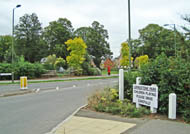
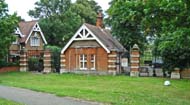
The entrance to Livingstone Park (left). The former lodge with adjoining gatekeeper's office remains.

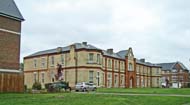
The former administration building.


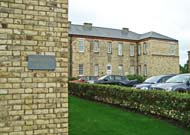
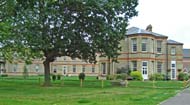
A few yellow and red brick villas with slate roofs survive.

New housing surrounds the old villas.
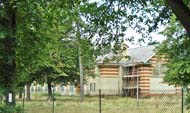
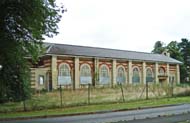
The Grade II listed chapel is to become a community centre.
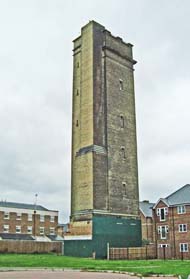

The water tower, surrounded by new housing, dominates the site.
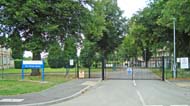
The entrance to Horton Haven.
Following transfer of the malaria therapy unit from Manor Hospital, a mosquito-proof ward with 12 beds was established at the Horton Hospital, together with two small rooms to serve as laboratories.
Horton Hospital became especially famous for the research work carried out in its Malaria Laboratory in the 'C' Hospital, which was under the aegis of the Ministry of Health. It became the centre for mosquito breeding in the UK, exporting malaria-infected mosquitoes to other centres involved in malaria therapy.
Uninfected mosquitoes were kept in an 'insectiary' or mosquito farm. Batches of mosquitoes were then infected by placing them in jars which were then applied to the thigh of a patient with malaria. When the infection had developed in the mosquitoes, 15-20 of them were taken in a jar to the patient receiving malaria therapy. The gauze-covered end of the jar was then applied to the patient's thigh and the insects given an opportunity to bite. At least ten bites were considered optimal to be certain that the infection had been transmitted.
In May 1925 the first two patients, both women, with general paralysis of the insane (cerebral syphilis) received malaria therapy. Infected mosquitoes were allowed to feed on them in order to induce malarial fever, thus destroying the syphilitc bacteria.
The early trials had many failures, some fatal, as different combinations of drugs were tried to eradicate the bacteria while lessening the unwanted effects of the malarial infection. By 1935 some 700 patients had received treatment, 75% of whom had recovered from a condition that recently had been untreatable.
In the late 1920s 'C' Hospital was renamed the Mott Clinic, after the neuropathologist Sir Frederick Mott (1853-1926), Director of the LCC's Central Pathological Laboratory at Claybury Hospital, where he had done much pioneer work on syphilis of the brain. By this time increase in demand for treatment had led to the extension of the special wards, providing 23 beds.
During WW2 due to military action supplies of quinine for the treatment of malaria were greatly reduced, causing concern for the health of Allied service personnel stationed in Africa and the Far East in countries where malaria was endemic. However, the Mott Clinic, under maximum wartime security conditions, successfully undertook prophylactic and therapeutic trials of the synthetic drug mepacrine to replace quinine. (However, mepacrine, developed by German scientists during the 1930s, had side-effects, one of which was to turn the skin yellow).
After the war the introduction of penicillin for the early treatment of syphilis dramatically reduced the number of cases of general paralysis of the insane. Malaria therapy became redundant, but research into neurosyphilis continued. The Mott Clinic and its laboratory became a malaria research centre and was renamed the Ministry of Health Malaria Laboratory. Its research continued in the development of a new anti-malarial drug - paludrine.
In 1952 it became the Horton Malaria Reference Laboratory. Various laboratory methods used in malariology were initiated at the Laboratory and, in 1960, it was appointed by the World Health Organisation as its Regional Malarial Centre for Europe.
In 1975 it moved to the London School of Hygiene and Tropical Medicine, becoming the Health Protection Agency Malaria Reference Laboratory.
Covell G, Nicol WD 1951 Clinical, chemotherapeutic and immunological studies on induced malaria. British Medical Bulletin 8, 51-55.
Covell J 1955 Developments in the chemotherapy of malaria during the last 40 years. Journal of the Royal Society for the Promotion of Health 75, 758-760.
Rollin HR 1994 The Horton Malaria Laboratory, Epsom, Surrey (1925-1975). Journal of Medical Biography 2, 94-97.
www.aim25.ac.uk
www.epsomandewellhistory explorer.org.uk
Abdy C 2001 Epsom Past. Chichester, Phillimore.
Lord JR 1920 The Story of the Horton (Co. of London) War Hospital: Epsom. Its Inceptions and Work and Some Reflections. London, W. Heinemann.
Thomas A 2004 Horton Hospital Epsom - asylum to housing estate. Surrey History 7, 26-26.
Valentine R 1996 Asylum, Hospital, Haven. A History of Horton Hospital. London, Riverside Mental Health Trust.
http://derelictmisc.org.uk
http://hansardmillbanksystems.com
http://urbandesertion.squarespace.com
www.1914-1918.net
www.aim25.ac.uk
www.countyasylums.com
www.ctie.org.uk
www.epsomandewellhistoryexplorer.org.uk
www.epsom-ewell.gov.uk
www.epsomprotectionsociety.co.uk
www.francisfrith.com
www.simoncornwall.com
www.studymore.org.uk
www.surreycc.gov.uk
www.thetimechamber.co.uk
www.timesonline.co.uk
Return to home page